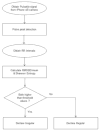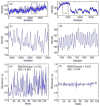A novel application for the detection of an irregular pulse using an iPhone 4S in patients with atrial fibrillation
- PMID: 23220686
- PMCID: PMC3698570
- DOI: 10.1016/j.hrthm.2012.12.001
A novel application for the detection of an irregular pulse using an iPhone 4S in patients with atrial fibrillation
Abstract
Background: Atrial fibrillation (AF) is common and associated with adverse health outcomes. Timely detection of AF can be challenging using traditional diagnostic tools. Smartphone use is increasing and may provide an inexpensive and user-friendly means to diagnoseAF.
Objective: To test the hypothesis that a smartphone-based application could detect an irregular pulse fromAF.
Methods: Seventy-six adults with persistent AF were consented for participation in our study. We obtained pulsatile time series recordings before and after cardioversion using an iPhone 4S camera. A novel smartphone application conducted real-time pulse analysis using 2 statistical methods: root mean square of successive RR difference (RMSSD/mean) and Shannon entropy (ShE). We examined the sensitivity, specificity, and predictive accuracy of both algorithms using the 12-lead electrocardiogram as the gold standard.
Results: RMSDD/mean and ShE were higher in participants in AF than in those with sinus rhythm. The 2 methods were inversely related to AF in regression models adjusting for key factors including heart rate and blood pressure (beta coefficients per SD increment in RMSDD/mean and ShE were-0.20 and-0.35; P<.001). An algorithm combining the 2 statistical methods demonstrated excellent sensitivity (0.962), specificity (0.975), and accuracy (0.968) for beat-to-beat discrimination of an irregular pulse during AF from sinus rhythm.
Conclusions: In a prospectively recruited cohort of 76 participants undergoing cardioversion for AF, we found that a novel algorithm analyzing signals recorded using an iPhone 4S accurately distinguished pulse recordings during AF from sinus rhythm. Data are needed to explore the performance and acceptability of smartphone-based applications for AF detection.
Copyright © 2013 Heart Rhythm Society. All rights reserved.
Conflict of interest statement
Figures



Comment in
-
I left my smartphone at home and can't tell if I'm in atrial fibrillation.Heart Rhythm. 2013 Mar;10(3):320-1. doi: 10.1016/j.hrthm.2012.12.021. Epub 2012 Dec 27. Heart Rhythm. 2013. PMID: 23274367 No abstract available.
References
-
- Go AS, Hylek EM, Phillips KA, Chang Y, Henault LE, Selby JV, Singer DE. Prevalence of diagnosed atrial fibrillation in adults: National implications for rhythm management and stroke prevention: The anticoagulation and risk factors in atrial fibrillation (ATRIA) study. JAMA. 2001;285:2370–2375. - PubMed
-
- Wang TJ, Larson MG, Levy D, et al. Temporal relations of atrial fibrillation and congestive heart failure and their joint influence on mortality: The Framingham Heart Study. Circulation. 2003;107:2920–2925. - PubMed
-
- Wolf PA, Abbott RD, Kannel WB. Atrial fibrillation as an independent risk factor for stroke: The Framingham Study. Stroke. 1991;22:983–988. - PubMed
-
- Fuster V, Ryden LE, Asinger RW, et al. ACC/AHA/ESC guidelines for the management of patients with atrial fibrillation. A report of the American College of Cardiology/American Heart Association task force on practice guidelines and the European Society of Cardiology committee for practice guidelines and policy conferences (committee to develop guidelines for the management of patients with atrial fibrillation) developed in collaboration with the North American Society of Pacing and Electrophysiology. Eur Heart J. 2001;22:1852–1923. - PubMed

